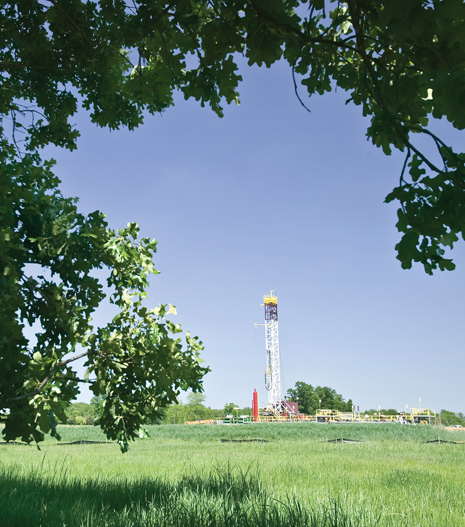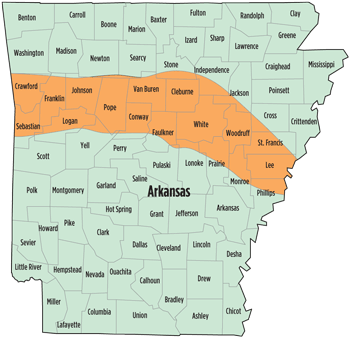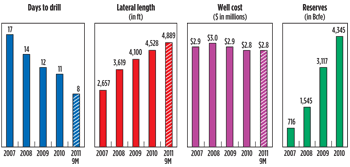KURT ABRAHAM, Executive Editor
 |
| A rig drills in the Fayetteville shale of Arkansas on behalf of dominant operator Southwestern Energy. The firm now has nearly one million acres under lease in the play. |
|
Over the last several years, it’s been a rollercoaster existence for the Fayetteville, the second-longest producing shale play in the U.S., exceeded only by the Barnett in North Texas. Since May 2001, there has been natural gas production from the Fayetteville, although drilling did not begin in earnest until 2002 and 2003. At that time, Southwestern Energy and its subsidiary, SEECO, Inc., researched the characteristics of this play and found that they could successfully apply horizontal drilling and hydraulic fracturing practices that were working so well in the Barnett.
The two firms began acquiring surface and mineral rights in the Arkoma basin, home to the Fayetteville. By the end of 2003, Southwestern Energy had spent about $11 million and acquired roughly 3,300 acres. Applying horizontal drilling on a wide-scale basis in 2004, the company suddenly struck pay dirt on one well after another. Although Southwestern and SEECO initially tried to keep these results under cover, their subsequent leasing frenzy soon became public. Several more operators entered the Fayetteville, such as XTO (now ExxonMobil), Chesapeake Energy and Petrohawk Energy, plus smaller independents. Yet, the number of operators has been smaller and more select than in the Barnett.
Capitalizing on their early bird status, Southwestern and SEECO enlarged their presence in the Fayetteville substantially in 2006 with a $700-million infusion. The two firms reinforced their devotion to this play the following year by pouring another $900 million into further development. Fueled by high natural gas prices, the Fayetteville by 2008 was figuratively on fire, as additional companies boosted their activity. Then came the U.S. economic recession, and gas prices fell dramatically in response to lower demand. Operators hung in with the Fayetteville during 2009, expecting that the economic situation would get better, sooner than later. Even so, activity did slow down, as companies shifted capital to newer shale plays. This was not due to issues with the Fayetteville, itself, which still had excellent long-term economics. Rather, it was an attempt by these firms to build low-cost positions in other areas before demand for leases would make it impossible.
Nevertheless, a quick economic recovery failed to materialize. As the recession lingered and gas prices remained stuck in a $3.50-to-$4.50/Mcf range, the Fayetteville’s short- to medium-term attractiveness began to deteriorate. By late 2011, two major players had exited, selling their gas holdings in favor of more liquids-rich plays elsewhere. The remaining operators also reconsidered their plans, scaling back activity until gas prices recover to a more consistently sustainable figure.
GEOLOGICAL PARAMETERS
The Fayetteville is an unconventional natural gas reservoir situated on the Arkansas side of the Arkoma basin. Its thickness ranges from 60 to 575 ft, and average depth is between 1,450 and 6,700 ft. This play is a Mississippian-age shale that is the geologic equivalent of the Caney shale found on the Oklahoma side of the Arkoma basin and the Barnett shale of north Texas.
Stretching across Arkansas from about Fort Smith, east to beyond Little Rock, the Fayetteville is approximately 50 miles wide from north to south, Fig. 1. The original, most active area of shale gas development has been from western Conway County through eastern White County. Development further to the east has proceeded at a slower pace, because the shale is considerably deeper, making gas extraction less economical.
 |
| Fig. 1. The Fayetteville shale extends from the Arkansas/Oklahoma border to east/northeast of Little Rock, cutting a roughly 50-mi-wide swath. |
|
Geologists say that the Fayetteville covers about 4,000 sq mi. Estimates of total resources range from 20 Tcf to 32 Tcf. The U.S. Energy Information Administration said that average well spacing is eight per square mile, while average, ultimate recovery is 2.25 Bcf per well.
According to the Powell Shale Digest, a study of gas output in the play shows that as of Dec. 1, 2011, cumulative production since May 2001 has been 2.51 Tcf from 3,730 producing wells. Production has extended over 10 counties, although the bulk of output has been in just five—from largest to smallest, they are Van Buren, White, Conway, Cleburne and Faulkner Counties. Together, they contain 96% of Fayetteville producing wells and account for 98% of cumulative gas production. As of December, 3,707 of 3,730 producing wells were operated by just three companies—Southwestern/SEECO, BHP Billiton (former Chesapeake properties) and XTO. Combined, these firms controlled 99.8% of cumulative production.
MAJOR TRANSACTIONS
As previously alluded, the U.S. recession that began in 2008 took a significant toll on Fayetteville operators, as natural gas prices languished. By late 2010, the bloom was off the rose for some firms, while others consolidated their holdings.
On Dec. 23, 2010, ExxonMobil, through XTO, paid $650 million for Petrohawk’s gas wells and pipelines in the Fayetteville. Petrohawk said that its Arkansas assets had been producing about 98 MMcfgd. The sale of the wells, alone, was $575 million. The purchase of the pipelines collecting gas from these Fayetteville wells amounted to $75 million.
The Petrohawk purchase boosted XTO’s Fayetteville holdings by about 40%. The price paid for estimated, proved reserves of 299 Bcf worked out to approximately $1.92/Mcf. The transaction gave ExxonMobil access to an additional 175,000 net acres in the Fayetteville, building on its existing 380,000-net acre position.
Meanwhile, as late as second-half 2009, Chesapeake was the second-largest producer in the Fayetteville and had 445,000 net acres under lease. Furthermore, the company had 4,100 drilling locations and operated 14 rigs. But by late 2010, the firm was ready to exit this play.
On Feb. 21, 2011, Chesapeake Energy announced the sale of its leasehold and other properties in the Fayetteville to Australia’s BHP Billiton Petroleum (BHP) for $4.75 billion. The deal included Chesapeake’s interest in roughly 487,000 net acres of leasehold and producing natural gas properties. It also included existing net production of about 415 MMcfd of gas equivalent, plus midstream assets that included 420 mi of pipeline. Chesapeake had proved Fayetteville gas reserves of 2.5 Tcf as of Sept. 30, 2010, indicating a value of $1.93/Mcf of proved reserves. However, pipeline assets are included in the sale price, so if one backs out $300 million in value for these assets, then the proved reserves are valued at $1.82/Mcf.
OPERATOR ACTIVITY
Despite recent downward revisions by Wall Street analysts for gas prices in the U.S. during 2012, Fayetteville producers don’t seem quite ready yet to completely halt drilling plans in this gas play—at least not for the moment. One thing that will prop up activity is the fact that operators still must fulfill a fair number of drilling obligations. Furthermore, unlike past downturns, when operators literally ceased drilling as gas prices dropped below consensus break-even levels, companies can still make some semblance of a profit in the current low-price environment by drilling at a reduced level. Overall, the three largest producers—Southwestern, BHP and XTO (ExxonMobil)—have said that they will still spend at least a combined figure of $3 billion on projects in the Fayetteville. Accordingly, here are the latest plans and activity by those leading operators.
Southwestern/SEECO. By far and away the largest Fayetteville operator, Southwestern has the luxury of developing its prime leasehold positions while enjoying the freedom brought by strong cashflow and attractive hedging arrangements. The company holds roughly 916,000 net acreas in this shale play, with the main focus concentrated on Cleburne, Conway, Faulkner, Van Buren and White Counties of central Arkansas. Reserves are estimated at 4.345 Tcf of gas.
The firm has made consistent progress from year to year in drilling and developing the Fayetteville, Fig. 2. During 2010, Southwestern produced about 305.2 Bcf of gas equivalent, up from 243.5 Bcfe in 2009. The company placed 553 operated wells onstream during 2010, all of which were horizontal wells fracture-stimulated with slickwater.
 |
| Fig. 2. Over the last five years, Southwestern Energy and other operators have made continuous improvement, drilling longer laterals in less time while containing costs, and boosting production and reserves. |
|
For 2011, Southwestern had drawn up a drilling plan that called for 440 to 450 operated wells. However, by the end of the first nine months of last year, the firm had already put 418 operated wells on production, including 132 in the third quarter. Like the year before, all of these wells were horizontal, fracture-stimulated with slickwater. Drilling efficiency improved again, Fig. 2. As of late 2011, the company’s gross production rate in the Fayetteville had jumped to 1.9 Bcfgd, up from 1.5 Bcfgd a year earlier.
This year, Southwestern expects to devote $1.4 billion of its $2.34-billion capital budget to the Fayetteville. In tandem, the firm has heavily weighted its capital spending toward low-risk development drilling. As of a February update, the company now expects to drill 370 to 380 net wells in Arkansas during 2012, compared to 479 last year.
BHP. Expectations for BHP’s Arkansas acreage have cooled off a bit since the firm acquired Chesapeake’s Fayetteville holdings in June 2011. Last fall, BHP Petroleum CEO Mike Yeager had predicted that the Australian company would increase drilling in Arkansas during both 2012 and 2013. At the time, Yeager had said that BHP planned to boost drilling in the Fayetteville to 20 rigs, starting in January 2012. This would have been more than double the nine operating rigs in 2011. The rig increase had been slated as part of $1 billion in investment that BHP had planned for this year.
Now, however, all that boundless optimism has subsided, along with the futures price for natural gas. In a presentation to financial analysts last month, BHP Billiton Ltd. CEO Marius Kloppers said that the holding company is now “selectively developing the most productive areas in our dry gas fields.” Kloppers said BHP will shift its efforts toward liquids-rich plays like the Eagle Ford shale in southern Texas. Since that meeting with analysts, BHP has announced plans to trim its drilling presence in the Fayetteville by three or four rigs, down to five or six, as opposed to nine last year.
XTO (ExxonMobil). Since acquiring XTO in 2010, ExxonMobil has acquired additional acreage in the Fayetteville and now has about 560,000 net acres under lease. So far, the firm has been tight-lipped about its planned activities for the Fayetteville this year. However, in a speech to the SPE Unconventional Gas Conference last June in Houston, XTO President Jack Williams confirmed that the company’s Fayetteville “drillwell” inventory (potential drilling locations) “is now in excess of 10,000 wells.” Furthermore, ExxonMobil has stated publicly that it estimates that it can double production from the company’s various shale and tight gas plays over the next decade. During 2010, XTO’s gross Fayetteville output was about 250 MMcfgd.
TECHNOLOGY APPLICATIONS
As one of the earlier U.S. shale plays, the Fayetteville has built up a sizeable track record over the last 10 years, with several thousand wells having been drilled. In the process, operators have run into a number of technical challenges requiring innovative solutions. The following items summarize some recent technical applications.
Multi-stage fracturing system increased production in Fayetteville formation. In the Fayetteville, Baker Hughes’ FracPoint multi-stage fracturing system provided a completion method using packers to isolate sections of the wellbore (stages) and frac sleeves to direct the frac treatment to the desired stage, Fig. 3. Use of this type of completion eliminated the need for cementing the liner, coiled tubing operations and wireline operations, while significantly reducing overall pumping time.
 |
| Fig. 3. Use of a new multi-stage fracing system in the Fayetteville reduced pumping time during the procedure and ultimately increased gas production from the affected wells. |
|
Upon reaching the setting depth, a setting ball was circulated down to the ball seat sub. The appropriate amount of pressure was applied to set the hydraulically actuated openhole packers and casing packer. By continuing to pressure up, the running tool was released, and the running string was pulled out of the well. At this point, the rig was moved to the next location. One month later, the fracturing crew was called out to location, and the fracturing began. The pressure-activated sleeve (P-sleeve) was opened first by simply applying pressure, and the first frac was performed.
Once the frac was complete for this stage, the ball corresponding to the second stage was dropped into the flow path without shutting down the pumping operation. When the ball seated for the second stage, pressure was applied to open the sleeve, and the second fracture was started. This process was repeated until all eight stages were successfully fractured, using 1.25 million lb (566 990 kg) of sand, and rates of up to 80 bbl/min. Once the well was put on production, the initial output was more than five times the group average of offset vertical wells.
Efficiently developing Fayetteville shale gas reserves: Percussion drilling solves application challenges/reduces drilling costs. Recently, a Fayetteville operator completed several high-flowing gas producers in White County. As described in a recent SPE paper by several Schlumberger authors, the multiple wells required to efficiently develop the gas reserves are usually drilled from one pad. To reduce costs and help maintain hole verticality, the operator has been drilling the surface and vertical intermediate hole sections with percussion air tools. The advantages of drilling with air as the circulating medium, rather than mud, are significant. Percussion drilling delivers faster ROP compared to rollercone bits, and reduces mud costs and incidence of lost circulation.
Challenges in the intermediate section include potential hole deviation from vertical and lithology/formation issues. The overburden is composed of highly interbedded shale, and hard, abrasive sandstone that can significantly reduce bit life. The sandstone section is responsible for dulling the hammer bit’s cutting structure, reducing its ability to accumulate additional footage while slowing ROP. Historically, the hole section has required up to four bits to reach TD.
To extend hammer bit life and increase total footage capabilities, an innovative overlapping/adjacent gauge row layout was designed and manufactured. The new hammer bit was run with good results. An engineering analysis was performed, comparing the average footage drilled with the new-style bit on 73 runs versus 196 runs with conventional hammer bits. Utilizing the new bit technology enabled the operator to drill approximately 58% more footage at high ROP. The increased durability has reduced the number of bits/trips required to complete the interval. 
|






